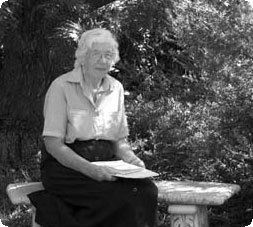 |
 |
|
Shirley DurrantShirley Durrant’s family, the McKindlays, were among the original European settlers in the southern Riverina, taking up a selection in the late 1800s. Essentially graziers, they looked to the development of irrigation in their region to improve productivity and security. INTERVIEW TRANSCRIPTThe original interview with Shirley Durrant was recorded in December, 2005. This is an edited version of that interview. Key topics: Caldwell, Womboota, Thule Lagoon, stock water, opening of Lawson Syphons, channel construction, learning about irrigation. I was born and bred in the Southern Riverina. I grew up at Womboota in the 40s when droughts and dust storms seemed to be the norm. We moved to Caldwell district, which is 20 odd miles further west, because Caldwell was going to be included in irrigation, whereas Womboota was to miss out. So we moved to Caldwell in 1946. My parents were Don and Rowena McKindlay. I attended school firstly at Womboota and later at Caldwell and then I went to boarding school for the next six years. I came back home and I helped on the farm until I was married. The coming of irrigation had always been a topic of discussion for our family, from the point of view that Womboota missed out. Womboota is too high, it’s above the area that could be irrigated so it was always dry and father actually owned the block of land that had a Murray Irrigation channel just go through one corner but he couldn’t water from it because the land was too high. So, he was keen to get the security of irrigation and that is why he sold the land at Womboota and moved to Caldwell. We moved there in November 1946. Thule, which is where we moved to in the Caldwell district, is on the edge of the Thule Lagoon which is the original bed of the Murray River. Now one year in six it fills with water and the water stays in it for a couple of years. Then when it dries it makes an excellent area for cropping so it was always cropped when it was dry. Apart from that there was very little cropping; it was 90% sheep farming. When we first went to Caldwell, rabbits were a major thing and my early memories of life at Caldwell were sitting under a pepper tree, and heavens only knows why we were under a pepper tree ~ there were thousands of mosquitoes ~ cutting up rotten apples which were then fed out to the rabbits and then on the third night the apples were poisoned and the next day you went out and gathered up hundreds and hundreds of dead rabbits Irrigation came before I was married ~ it was there by 1956, I think, and I wasn’t married until 1958. I married a school teacher and we went north for 2 ˝ years. When we came back we were on part of Thule and my husband Knox farmed in partnership with my father. Irrigation undoubtedly was the biggest change we saw, because it brought about the other changes. Through that area there were a number of properties divided and that brought added population which meant power was viable, and it came through in the 1960s. But water undoubtedly was the major change. From the point of view of stock water, the water supply was extremely reliable. In the 40s because there was no natural water through the area, stock were frequently transferred down to Gippsland on agistment for months and months on end over the summer because there wasn’t . . . so even in the poorest year at least we’ve got stock water. I remember the day at the opening of the Lawson Syphon seeing that water come up under the river and people cheering and people everywhere, it was all lined up along the banks of the channel on the south side and there were flags draped across the outlet of the channel and we all stood there expectantly and Mr Lawson and everyone else who made speeches, I can’t remember anything about the speeches actually. And then, I don’t know what they did, if they pulled the button or pressed the lever and the water just came through as this trickle, it didn’t come through as a dramatic whoosh, it just came through as a slow trickle and by the time we left it was as far as you could see, trickling down, so when I say a trickle it was a stream six feet wide but it, it wasn’t a rush it was just a gradual filling of the channel. I don’t actually remember the first trickle past the farm which is very funny, you might have thought that would have made a bigger impression. But I’ve got no recollection of it filling the channel at home” “Then the channels came through ~ I think most of them were built by teams of horses. There were occasional contractors who had tractors, but most were constructed by horse teams and the contractors’ wives tended to travel with their husbands and had caravans and just camped on the site literally and moved on as they did 10 or so miles, just moved on a bit further.” Irrigation was a learning curve, learning from each other and from neighbours. The Department of Agriculture was there but it was more learning from others. There was quite an influx of young sharefarmers that came down who had experience up at Griffith and with the increased workload quite a few properties put on men to help and they were very often either employees or sharefarmers who had experience at Leeton.” “We had an employee for a number of years who had been a sharefarmer and he was the one who grew the rice originally and set us on the right track. “I think irrigation brought the greenness to the area. As a childhood memory there was so much more the dust storms and the dryness and having to send sheep away from a lack of water. Water is such a vital part in our area just the green contrast, particularly in summer. I don’t want to get you wrong, it wasn’t always just a dry dust bowl, it’s a very pretty area in winter with a little rain, which it doesn’t seem to anymore. But, just the constancy of summer, to have that greenness outside the house when it’s hot is wonderful. |
You'll need to get the Flash Player to hear the audio. |
|
| sitemap • credits
& references • copyright • local
history links • contact & contribute • VISITORS |
||
